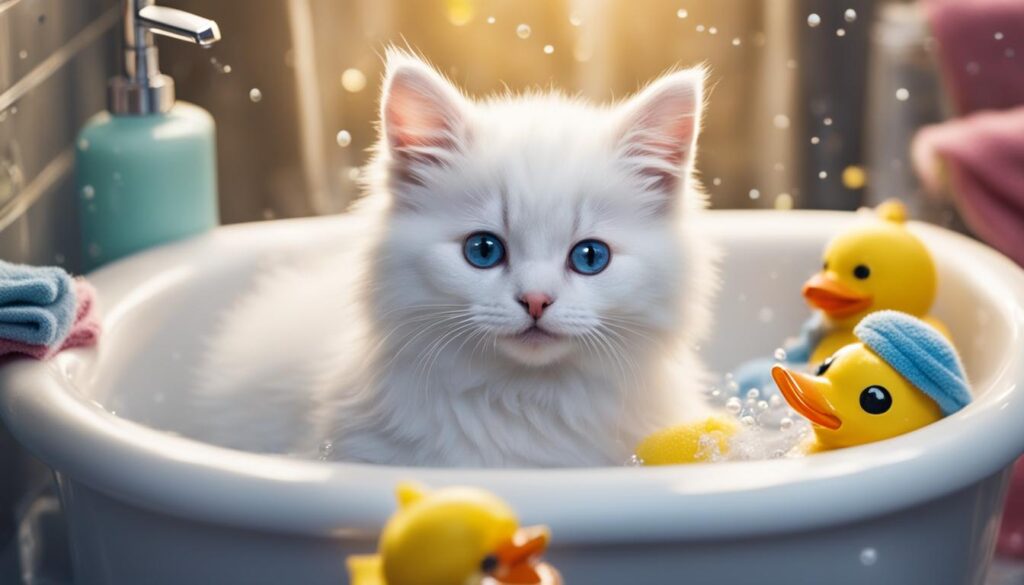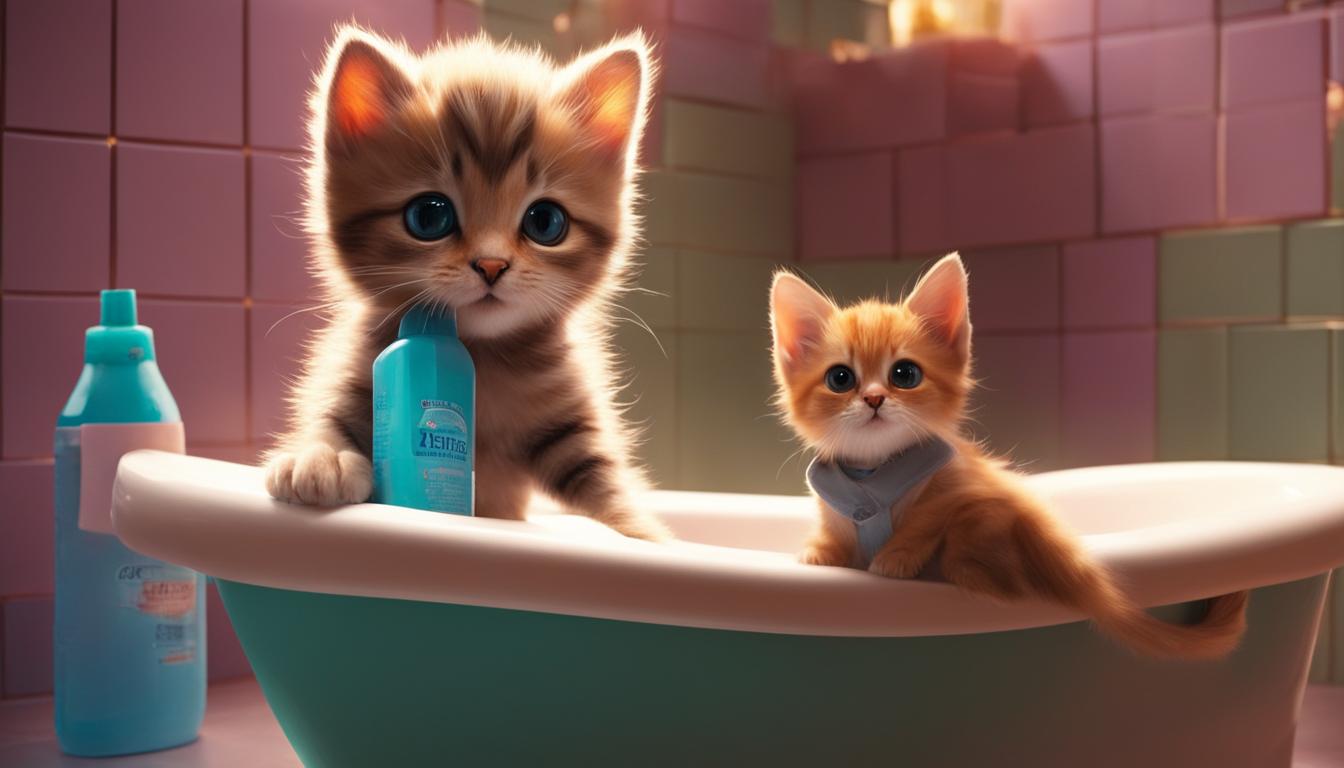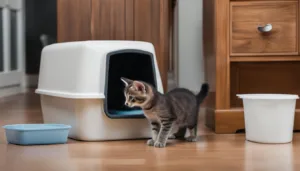Cats are known for their grooming habits and can usually keep themselves clean without intervention. However, there are times when a cat may need a bath, such as if they come into contact with something dangerous or smelly. Here are some essential tips for bathing a kitten with minimal stress.
- Trim the Toenails and Brush Before Bathing
- Time It Right for a Calmer Bathing Experience
- Kitten Hygiene Routine: Providing Traction and Using Lukewarm Water
- Use a Pour-Over Method and Cat-Safe Shampoo
- Kitten Grooming Tips: Rinse Thoroughly and Be Gentle with the Face
- Bathing Recommendations for Young Kittens
- Getting Your Kitten Comfortable with Water
- Bathing Supplies and Step-by-Step Guide
- Conclusion
- FAQ
- Source Links
Key Takeaways:
- Understanding when to bathe a kitten is crucial for their overall hygiene.
- Follow a bathing schedule for kittens that ensures they receive regular cleaning without causing unnecessary stress.
- Implement effective kitten grooming tips to make bath time a positive experience for both you and your furry friend.
- Trimming the kitten’s nails and brushing their fur before bathing can help prevent accidents and make the process smoother.
- Choose the right time for a bath when the kitten is tired and more likely to stay calm and cooperative.
Trim the Toenails and Brush Before Bathing
Before giving your kitten a bath, it’s important to take a few steps to prepare them. First, trim your kitten’s toenails to prevent any accidental scratches during the bathing process. Use pet nail clippers designed specifically for small animals and be cautious not to cut too close to the quick. If you’re unsure about trimming the nails yourself, consult your veterinarian for guidance or consider seeking professional grooming services.
In addition to trimming the nails, it’s also beneficial to brush your kitten’s fur before the bath. This helps remove any loose fur and mats, making it easier to get them clean during the bathing process. Use a kitten-specific brush or a brush with soft bristles to gently remove any tangles or debris from their coat. Brushing beforehand not only helps keep their fur clean but also prevents excess fur from clogging the drain during the bath.
By trimming your kitten’s nails and brushing their fur before bathing, you can help create a more comfortable and enjoyable experience for both you and your feline friend.
Time It Right for a Calmer Bathing Experience
When it comes to bathing a kitten, timing is key to ensure a calm and stress-free experience. Choosing the right moment when the kitten is tired and mellow can make a significant difference. Consider giving the bath after playtime, when the kitten is more likely to be relaxed and less resistant.
Having someone to assist you during the bath can also be helpful. This person can help hold the kitten securely and prevent any accidental scratches. Their presence can provide an extra level of comfort and support for both you and the kitten.
By picking the best time and having a helping hand, you can create a more positive bathing environment and make the experience smoother for everyone involved.
Additional Tips for a Successful Bath
- Make sure the bathing area is warm and quiet to minimize distractions and discomfort for the kitten.
- Prepare all necessary supplies, such as a non-slip mat for traction and lukewarm water, before bringing the kitten to the bathing area.
- Use a gentle, cat-safe shampoo specifically formulated for kittens to avoid any potential skin irritation.
- Rinse off all the shampoo thoroughly to prevent any residual soap from causing skin problems.
- Be extra gentle when handling the kitten’s face and avoid getting water or shampoo near their eyes and ears.
- After the bath, dry the kitten thoroughly using a soft towel and reward them with treats and praise for their cooperation.
Following these bathing guidelines and tips can help ensure that the experience is as calm and pleasant as possible for your kitten. Remember, patience and positive reinforcement are key to building trust and making bath time a positive bonding experience.
Kitten Hygiene Routine: Providing Traction and Using Lukewarm Water
When it comes to bathing a newborn kitten, it’s important to create a safe and secure environment. One way to do this is by providing traction in the bath. Placing a folded towel or rubber bath mat in the tub can help prevent the kitten from slipping and provide them with a sense of stability. This will help reduce their anxiety and make the bathing experience more comfortable for both of you.
In addition to providing traction, using lukewarm water is crucial for the kitten’s comfort and safety. Cats are sensitive to extreme temperatures, and hot water can easily cause burns or overheating. Aim to fill the tub with lukewarm water that is around 101-103 degrees Fahrenheit. This temperature will be soothing for the kitten and ensure a gentle and enjoyable bathing process.
Table: Ideal Water Temperature for Bathing a Newborn Kitten
| Age | Ideal Water Temperature (°F) |
|---|---|
| 0-2 weeks | 100-102 |
| 2-4 weeks | 101-103 |
| 4-8 weeks | 102-104 |
Remember, maintaining a proper kitten hygiene routine is essential for their overall well-being. By providing traction in the bath and using lukewarm water, you can ensure a safe and comfortable bathing experience for your newborn kitten.
Bathing a Newborn Kitten: Tips for a Positive Experience
Bathing a newborn kitten can be a delicate process, so it’s important to follow a few extra precautions:
- Support the kitten’s body with one hand while using the other hand to gently wet and wash them.
- Be cautious around the kitten’s face, avoiding the eyes and ears during the bath.
- Use a gentle touch when handling the kitten to avoid causing any stress or discomfort.
- Keep the bath time short and efficient to minimize any potential stress for the kitten.
Following these tips will help ensure that bathing a newborn kitten becomes a positive and bonding experience for both you and your furry friend.
Use a Pour-Over Method and Cat-Safe Shampoo
When it comes to bathing a kitten, it’s important to use a method that is gentle and minimizes stress. Most cats don’t enjoy being fully submerged in water, so a pour-over method can be a more suitable option. Instead of immersing the kitten in water, use a handheld sprayer or pour lukewarm water over their body with a cup or pitcher. This allows you to control the amount of water they are exposed to and reduces the risk of causing fear or discomfort.
In addition to the pour-over method, it’s crucial to use a cat-safe shampoo specifically formulated for felines. Human shampoos can be harsh on a kitten’s delicate skin and may contain ingredients that are toxic to them. Look for a shampoo that is gentle, hypoallergenic, and free of any harsh chemicals or fragrances. Using a cat-safe shampoo ensures that you are providing the best care for your kitten’s coat and skin during the bath.
Remember to always follow the instructions on the shampoo bottle and dilute it if necessary. It’s important to rinse the shampoo thoroughly from the kitten’s fur, as any residue left behind can cause skin irritation or be ingested when the kitten grooms itself. Taking these precautions will help ensure a safe and effective bathing experience for your young kitten.
Table: Cat-Safe Shampoos for Kittens
| Brand | Description | Price |
|---|---|---|
| Feliway | Gentle formula that cleans and conditions the coat without stripping natural oils. Suitable for kittens 12 weeks and older. | $10-15 |
| Burt’s Bees | Natural shampoo enriched with buttermilk to nourish and soothe the skin. Ideal for sensitive kittens. | $8-12 |
| PetHonesty | Organic shampoo that moisturizes and detangles the fur. Formulated with aloe vera and chamomile extract for gentle cleansing. | $12-18 |
| Earthbath | Hypoallergenic and fragrance-free shampoo suitable for kittens with allergies or sensitivities. Made with natural ingredients. | $10-14 |
Kitten Grooming Tips: Rinse Thoroughly and Be Gentle with the Face
Properly bathing a kitten involves more than just applying shampoo and rinsing it off. It’s important to rinse thoroughly to prevent skin irritation and ingestion of soap. Additionally, the delicate face of a kitten requires special care during the bathing process. Here are some essential tips to help you properly rinse and be gentle with your kitten’s face during bath time.
Rinse Thoroughly
After applying the shampoo and lathering your kitten’s fur, it’s crucial to rinse off all the soap to prevent any residue from causing skin irritation. Make sure to thoroughly rinse every part of the kitten’s body, paying extra attention to harder-to-reach areas such as the belly and armpits. This will ensure that your kitten’s coat is clean and free of any potential irritants.
Gentle Face Cleaning
The face of a kitten is sensitive, and it’s important to handle it with care during the bathing process. Instead of pouring water directly over the face, which can cause discomfort and stress, use a warm, damp washcloth to gently wipe the face. Start from the forehead and work your way down, avoiding the eyes and ears. This method allows you to clean the face effectively without causing any harm or discomfort to your kitten.
Remember, kittens have delicate skin and should be handled with care during bath time. By rinsing thoroughly and being gentle with the face, you can ensure a positive bathing experience for your furry friend.

| Key Tips: |
|---|
| Rinse thoroughly to prevent skin irritation and ingestion of soap residue. |
| Use a warm, damp washcloth to gently clean the kitten’s face, avoiding the eyes and ears. |
Bathing Recommendations for Young Kittens
When can I start bathing my kitten? It’s a common question that new kitten owners often ask. Bathing a young kitten requires careful consideration and proper technique to ensure their safety and comfort. Here are some recommendations to help you navigate the bathing process with your young kitten.
When to Start Bathing
It’s generally recommended to wait until a kitten is at least eight weeks old before giving them their first bath. By this age, they have developed better control over their body temperature and coordination, making the bathing experience less stressful for them. However, if your kitten gets into something particularly dirty or sticky, you may need to bathe them earlier.
Introduce Positive Associations
To make the bathing experience a positive one for your kitten, introduce them to the bathing area gradually. Start by placing them in an empty tub or sink with a few treats or their favorite toy. This will help them associate the bathtub with positive experiences and reduce their anxiety during future baths. Additionally, make sure to use a gentle and calming voice while bathing them to help keep them relaxed.
Use Gentle Techniques
When bathing a young kitten, it’s important to use gentle techniques to avoid causing them any distress or harm. Use lukewarm water and a mild kitten-safe shampoo to clean their fur. Be careful around their face, ears, and eyes, using a damp cloth instead of pouring water directly on those areas.

Table: Kitten Bathing Checklist
| Supplies | Description |
|---|---|
| Bathing container | A shallow tub or sink |
| Warm water | Between 101-103 degrees Fahrenheit |
| Kitten-safe shampoo | Mild and specifically formulated for cats |
| Treats | To reward good behavior |
| Towel | For drying the kitten |
Remember, patience and positive reinforcement are key when bathing your young kitten. With proper preparation and gentle techniques, you can ensure a safe and stress-free bathing experience for both you and your furry friend.
Getting Your Kitten Comfortable with Water
Bathing a kitten can be a challenge if they are not accustomed to water. However, with patience and gradual exposure, you can help your kitten become more comfortable with being wet. Start by introducing your kitten to water in a gentle and positive way.
Begin by gently wiping your kitten with a wet washcloth. Use lukewarm water and make sure to offer treats and praise to create a positive association. Over time, gradually progress to having your kitten stand in a shallow pan of water while using the washcloth to wet their body.
As your kitten becomes more comfortable, continue to increase their exposure to water. Eventually, they should be comfortable with being fully wet and ready for a full bath. Remember to always go at the kitten’s pace and provide plenty of positive reinforcement throughout the process.
By taking the time to gradually introduce your kitten to water, you can help them develop a positive association with bathing and ensure a more relaxed and enjoyable experience for both of you.

| Steps | Instructions |
|---|---|
| Step 1 | Begin by gently wiping your kitten with a wet washcloth. |
| Step 2 | Offer treats and praise to create a positive association. |
| Step 3 | Progress to having your kitten stand in a shallow pan of water with the washcloth. |
| Step 4 | Continue to gradually increase your kitten’s exposure to water. |
| Step 5 | Provide positive reinforcement throughout the process. |
Conclusion
Helping your kitten become comfortable with water is an important step in their grooming routine. By introducing water gradually and using positive reinforcement, you can make bath time a more pleasant experience for both you and your furry friend.
Bathing Supplies and Step-by-Step Guide
Before you begin bathing your kitten, it’s important to gather all the necessary supplies to ensure a smooth and successful bathing experience. Here’s a list of essential bathing supplies:
- A shallow bathing container or sink
- A cup or pitcher for pouring water
- Kitten-safe shampoo
- A towel
- Treats (for rewards)
Once you have all the supplies ready, it’s time to create a warm and safe bathing environment for your kitten. Ensure that the water temperature is between 101-103 degrees Fahrenheit, which is ideal for a comfortable bath. Remember, too hot or too cold water can distress your kitten. Set up the bathing container in a secure location, such as a bathroom sink or a small tub.
Now, let’s go through a step-by-step guide for bathing your kitten:
- Gently wet your kitten’s fur using the cup or pitcher, starting from the back and working your way towards the head. Avoid getting water in the ears, eyes, and nose.
- Apply a small amount of kitten-safe shampoo to your hands and lather it gently onto your kitten’s fur. Be careful not to rub too vigorously as it may cause discomfort.
- Rinse off the shampoo thoroughly using the cup or pitcher with lukewarm water. Ensure that no soapy residue is left on your kitten’s fur.
- Wrap your kitten in a large towel and gently dry off the excess moisture. You can also use a hairdryer on a low, warm setting if your kitten is comfortable with it.
- Finally, reward your kitten with treats and praise for their good behavior during the bath. This positive reinforcement will help create a more positive association with bathing in the future.
| Step | Instruction |
|---|---|
| 1 | Gently wet your kitten’s fur using the cup or pitcher, starting from the back and working your way towards the head. Avoid getting water in the ears, eyes, and nose. |
| 2 | Apply a small amount of kitten-safe shampoo to your hands and lather it gently onto your kitten’s fur. Be careful not to rub too vigorously as it may cause discomfort. |
| 3 | Rinse off the shampoo thoroughly using the cup or pitcher with lukewarm water. Ensure that no soapy residue is left on your kitten’s fur. |
| 4 | Wrap your kitten in a large towel and gently dry off the excess moisture. You can also use a hairdryer on a low, warm setting if your kitten is comfortable with it. |
| 5 | Finally, reward your kitten with treats and praise for their good behavior during the bath. This positive reinforcement will help create a more positive association with bathing in the future. |
Bathing your kitten can be a bonding experience while also maintaining their hygiene. By following these steps and using the right supplies, you can ensure a comfortable and stress-free bath for your little feline friend.

Conclusion
When it comes to bathing a young kitten, following proper grooming tips and bathing recommendations is essential for their well-being. Remember, most cats are natural groomers, but there are situations where a bath is necessary. By keeping a few key tips in mind, you can make the bathing experience more comfortable and stress-free for both you and your kitten.
Start by trimming your kitten’s nails and brushing their fur before the bath to prevent scratches and make the process smoother. Choose a calm time when your kitten is tired, and enlist the help of someone to hold them during the bath. Provide traction in the tub with a towel or rubber mat and use lukewarm water to ensure their comfort.
When it’s time to bathe, opt for a pour-over method or handheld sprayer to minimize stress. Use a cat-safe shampoo specifically formulated for their delicate skin. Rinse thoroughly after shampooing and be gentle when cleaning their face, using a warm, damp washcloth. Afterward, ensure your kitten is dried thoroughly and rewarded with treats and praise.
Gradually getting your kitten comfortable with water is important, so start with gentle introduction and progress at their pace. And finally, gather the necessary supplies and follow a step-by-step guide to make the bathing process easier and more efficient. By incorporating these grooming tips and bathing recommendations into your routine, you can help keep your kitten clean and healthy.
FAQ
When should I bathe a kitten?
Kittens typically do not need regular baths as they are capable of grooming themselves. However, there may be instances when a bath is necessary, such as if they come into contact with something dangerous or smelly.
How often should I trim my kitten’s nails?
It is important to trim your kitten’s nails regularly to prevent accidental scratches. Aim to trim them before bathing to minimize the risk of scratches during the bathing process.
What is the best time to give a kitten a bath?
Choose a time when the kitten is tired and mellow, such as after playtime. This can help make the bathing experience less stressful for both you and the kitten.
What should I do to prevent my kitten from slipping in the tub?
To provide traction, place a folded towel or rubber bath mat in the tub. This can help the kitten feel more secure and prevent accidents.
Should I use hot water to bathe a kitten?
No, hot water can easily overheat cats. Aim for lukewarm water when filling the tub to ensure the kitten’s comfort and safety.
Can I use regular shampoo on my kitten?
No, it is crucial to use a cat-safe shampoo specifically formulated for cats. Human shampoos can be harmful to cats.
How can I clean my kitten’s face during a bath?
Avoid pouring water over the kitten’s face or using shampoo. Instead, use a warm, damp washcloth to gently wipe the face, taking care to avoid the eyes and ears.
How should I dry my kitten after a bath?
Thoroughly dry the kitten with a large towel and keep them in a warm room until completely dry. If the kitten allows, you can also use a hairdryer on a low, warm setting.
How can I get my kitten comfortable with water?
Gradually introduce your kitten to water by gently wiping them with a wet washcloth and offering treats. Slowly increase their exposure to water until they are comfortable with being fully wet.
What supplies do I need to bathe a kitten?
Gather necessary supplies such as a bathing container, cup for pouring water, kitten-safe shampoo, treats, and a towel. Having these items ready will make the bathing process smoother.




